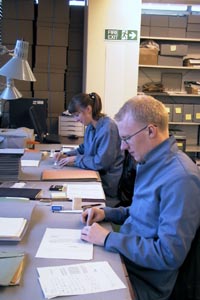Conservation Projects
Preserving Twentieth-century Folder-based Clinical Case Notes
Background
LHSA has a large and important collection of twentieth-century folder-based case notes, with around thirty specialties and over fifty physicians and surgeons represented. They are a scarce local and UK resource with potential international significance.
LHSA has been fortunate to be awarded five separate project grants from the Wellcome Trust’s Research Resources in Medical History programme to conserve and re-house this material.
- Preserving twentieth-century hospital case notes of University of Edinburgh clinical professors: Edwin Bramwell and Norman Dott ran from June 2002 to June 2003.
- Preserving twentieth-century hospital case notes of University of Edinburgh clinical professors: James Learmonth and Derrick Dunlop ran from April 2004 to April 2005.
- Preserving twentieth-century case notes of the Royal Edinburgh Hospital ran from July 2005 to January 2007.
- Preserving Edinburgh’s twentieth-century reproductive and sexual health case notes ran from February 2007 to April 2009.
- Preserving Edinburgh's twentieth-century case notes: treating tuberculosis and World War II injuries is a 6-month project that began in May 2009.
The case notes treated in these projects have been prioritised because they meet a range of intellectual, conservation and access criteria.
Condition
Heavy usage and inappropriate storage prior to accession has meant that the majority of the folder-based case notes are in poor condition and cannot be accessed without causing further damage. Surface dirt, folding and tearing are frequently noted. Metal paperclips and staples have caused extensive rust damage and the inferior quality of the folders poses risk of physical and chemical damage to their contents.
Treatment
A Project Conservator and a Conservation Assistant are employed to treat and re-house the case notes. Because of the large number, remedial treatment is restricted to surface cleaning with a chemical sponge, re-aligning folding and creasing to the paper and the removal of any paper clips and staples. Black and white photographic prints found within the case notes are given individual folders of photographic storage paper and retained within the original format. Parts of the original folders with informational content are retained and samples of each style of folder are kept for reference. Each case note is placed in a single crease paper folder constructed of good quality material within an equally high specification drop spine box. The new storage system is labelled appropriately and handling guidelines produced to ensure that future access is safe and easy.
Some case notes have x-rays and glass plate negatives that accompany the paper-based case note. Cellulose acetate X-rays in good condition are re-housed in cold storage. Cellulose acetate x-rays in very poor condition and cellulose nitrate x-rays are reformatted and subsequently destroyed. Extensive documentation and cross-referencing is undertaken to ensure that the informational content of the case notes is not compromised in any way. Glass plate negatives are housed vertically in good quality four-flap enclosures and boxes with plates of the same size wherever possible.
Extensive photographic and written documentation is produced and a final report submitted to the Wellcome Trust.
Conclusion
To date, c. 300,000 case notes have been treated. This represents c. 30% of LHSA’s total holdings of material of this nature. These projects have succeeded in securing the long-term preservation of, and improved access to, these medically and historically important case notes. In addition, a methodology for the preservation of folder-based clinical case notes has been developed which includes the treatment of photographic material (print and glass plate) and x-rays, as well as paper-based notes. This is sufficiently robust to be transferable to other historically significant folder-based collections of papers held by archives, record offices, libraries and other repositories.
Additional information
The projects are supervised by the LHSA Paper Conservator and managed by the LHSA Archivist. The experience gained and methodology developed is disseminated wherever possible via publications, presentations and tours. To get further information or ask advice on producing preservation proposals of this kind, please contact us.
Acknowledgements
LHSA gratefully acknowledges the support of the Wellcome Trust and thanks present and past project staff: Rosy Marshall, Kate Kidd, Louisa Coles, Toby Gough, Sue Turnbull, Simona Cenci and Katrina Redman.
 |
Designed by the Learning Technology Section, © The University of Edinburgh

